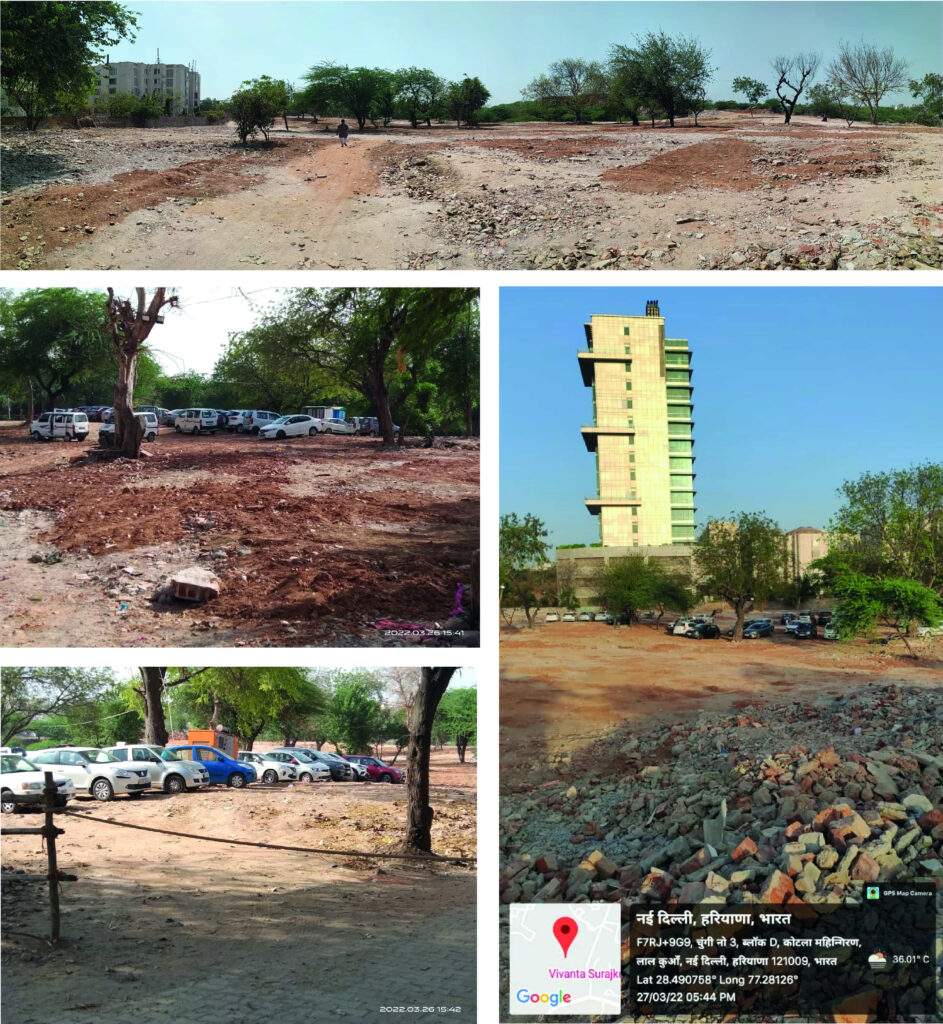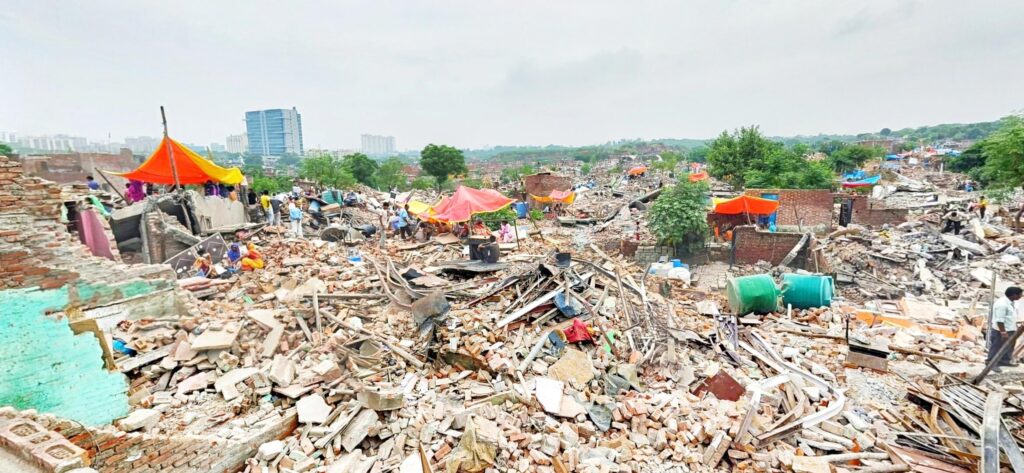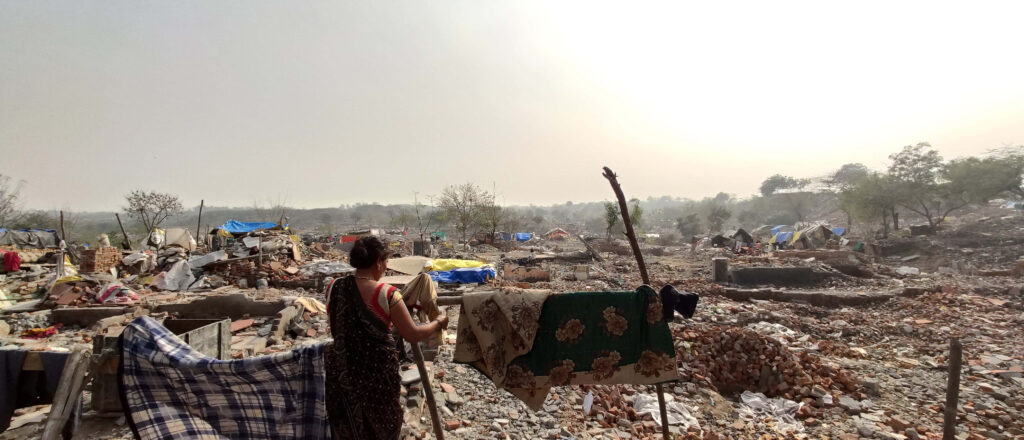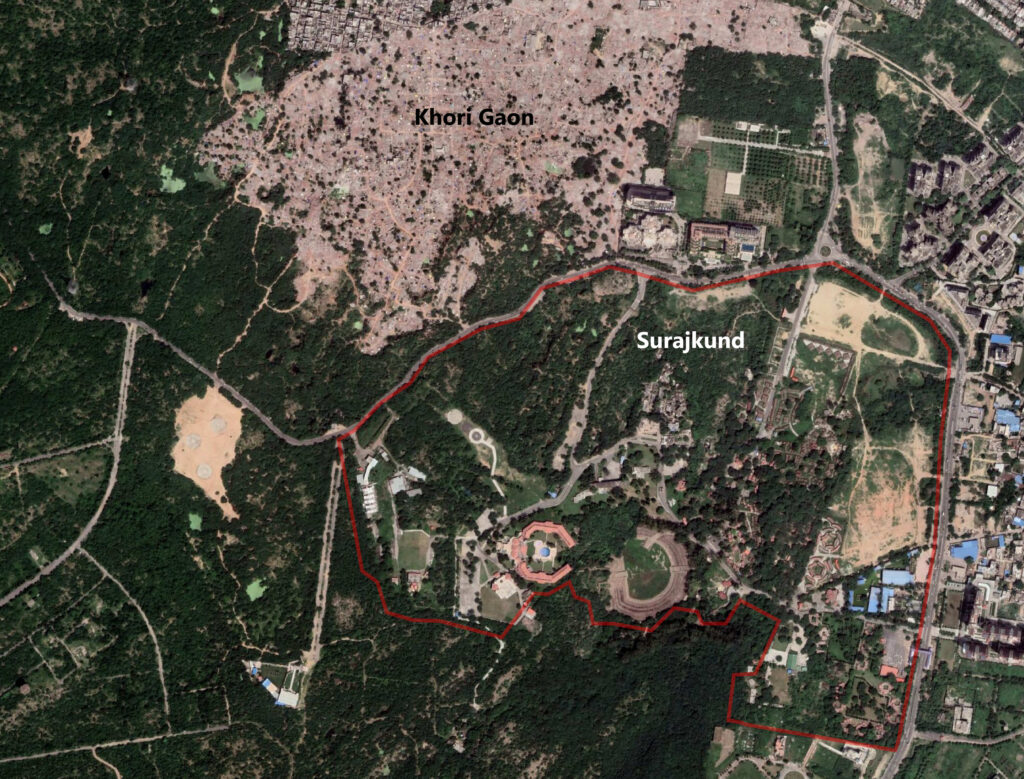“Land grabbers are talking of fairness? …This forest land has to be cleared. We [the Bench] don’t want these COVID-19 excuses. We cannot give any concession for forest land.”
On 7th June 2021, in the midst of the pandemic, the Supreme Court passed an order to evict the residents of Khori Gaon, a 50-year-old informal settlement that allegedly sits on forest land at the foothills of the Aravalli Range. Soon after, the State undertook one of the most brutal evictions in India between July and August 2021.
What was once a vast and dense human settlement cleared to make way for a forest was incidentally being used as a parking space, as recently as a week ago. In March 2022, the Haryana state cleared a portion of the land on which Khori Gaon stood to create a parking space for the Suraj Kund International Fair, organised by the Surajkund Mela Authority and Haryana Tourism. Here, international and domestic artisans come to display their art and other cultural events over one month. While arguing in favour of demolishing Khori Gaon, Haryana state lawyers had argued that the construction of these houses comes under what is termed as ‘non-forest’ activity. And yet, ironically, in this instance from March 2022, the same government has converted the demolished land into a parking space – a non-forest activity.

Bordering Delhi and Haryana, Khori Gaon had started developing when mining was rampant here in the 1970s and, by 2021, had grown to cover 120 hectares, housing approximately 1 lakh residents. After it was flattened, many informal settlements in the NCR were handed eviction orders under the guise of forest conservation, and some were partially bulldozed. Yet, the farmhouses, hotels, government buildings, gated communities and other institutional buildings that fall on forest land continue to stand tall. After this discrimination was pointed to the court, a legal battle has started between the different stakeholders, some to save the forest and others to save the high-end developments.
Khori Gaon’s lawyers have been highlighting the lack of due process and the vexed rehabilitation process. Unfortunately, this case is falling off the radar, and the fear is that the plight of Khori Gaon’s displaced residents will be forgotten soon. The abuse, mistreatment and erasure of the residents of Khori Gaon in the name of forest conservation is emblematic of the challenges that marginalised residents (being termed as ‘encroachers’) face across the country.
Khori Gaon’s Story So Far
The settlement’s story is tied intrinsically to the changes in the hills. The Aravallis was an 800 km continuous chain of hills and forests covering the states of Delhi, Haryana, Rajasthan and Gujarat. The area where Khori Gaon developed was called the Southern Ridge, and it played a vital role as a green buffer from desertification, as a natural drainage system, and in keeping droughts in check. However, due to excessive mining from the 1990s till 2008, land-grabbing and real estate development, the ecological character of the hills has deteriorated alarmingly. By the time mining was banned by the Supreme court between 1992 to 2008, the hills were fragmented. The terrain was left with exposed topsoil, filled with craters, vertical rock surfaces, and a depleted water table.
Worldwide, post quarry landscapes have become a challenge to maintain and redevelop. Often these polluted landscapes get abandoned as they are not fit for human habitation or further resource extraction. In Khori Gaon’s case, the urban poor had converted this degraded land into a habitable neighbourhood through their own labour. By the time the settlement started developing, there was no forest in that area.
The early settlers in Khori Gaon were quarry workers who had migrated from Rajasthan, Madhya Pradesh, Uttar Pradesh, Bihar, Jharkhand and West Bengal. They had settled down to the East, known as Purani Khori (Old Khori Gaon). Exploited by their employers, many were victims of bonded labour. They also suffered from silicosis yet continued to work as this was their only means of employment. Once mining was banned, they struggled to find jobs and were trapped in Khori Gaon as they had loans to repay. Soon after, the mafia grabbed the land, subdivided the area into small plots and sold it to the migrants and urban poor looking for affordable housing.
The newer development was given different names but was collectively often referred to as New Khori Gaon. Most people had sold their village land or their assets to migrate to the city in search of a better lifestyle. Many of the residents who moved here were also displaced from other informal settlements in Delhi in the name of urban development or environmental protection. Unlike the lie that has been repeatedly peddled in the media and the court that Khori Gaon residents were encroachers, residents had bought the land. Similarly, the older residents from Purani Khori, mostly quarry workers, had paid for the plot through their labour.
We have a power of attorney and an Aadhar card. Some even have voter id cards. How are we illegal?
—A Khori Gaon Resident
A question that has been repeatedly asked in the court and the public domain – Why do the urban poor or migrants move into an informal settlement? Why did they settle here despite it being a forest land? Due to the severe lack of affordable housing in the cities, the urban poor often have no other option other than moving into informal settlements. Though tenure insecurity is a looming threat, it is a trade-off to upgrade their lives, with respect to accessing education, health facilities, infrastructure and jobs. The answer to the second question is that when Khori Gaon started developing, there was no forest on the ground. It was a post-quarry landscape. There was no demarcation or any board cautioning the citizens that this was forest land.
Additionally, from time to time, politicians from Delhi and Haryana have come to ask for votes in return for providing services and the promise of authorisation. The residents did not know they were on forest land, were duped by the mafia, and were misled to believe the settlement would be regularised. After the start of the Supreme Court case, when they realised they were on forest land, officials from the forest department gave assurance that their houses won’t be demolished in return for bribes.
When I inquired whether this land was in Haryana, I was told it was in Delhi until the church [marked in red on the map below]. Besides the land dealers, even people we consider trustworthy—politicians, police, forest department officials—assured us that this land is in Delhi. [MLAs] Sahiram Pehalwan and Ramesh Bidhuri both have repeatedly mentioned this as well. When these prominent politicians tell us, how can we not believe them?
—A Khori Gaon Resident

Within 30 to 40 years, Khori Gaon had become a vibrant neighbourhood with a mix of residential, commercial, religious and educational spaces. Most roads were pedestrian-friendly and unpaved. The ground surface was predominantly permeable, which led to the conservation of the existing green cover in this area. Most residents had also planted trees in their courtyard or along the roads to create shade. As the settlement developed, the neighbouring areas started changing rapidly. On the Haryana side, Khori Gaon is surrounded by farmhouses, hotels, institutions and gated colonies. Even though all the focus has been on Khori Gaon for being situated on forest land, according to the National green tribunal (NGT), there are 123 constructions on forest land in Faridabad. Some of these are by Haryana government officials.
Also Read: Finding Delhi’s “Encroachers”: The Lal Dora Investigation
At this stage, it is important to note that whether the land upon which Khori Gaon stands is forest land or not, as per the 1900 Punjab Land Preservation Act (PLPA), is still being debated in court. In fact, this debate came up only after high-end developments were threatened with eviction after this settlement for the urban poor was demolished. So there could have been a scenario where Khori Gaon would have been destroyed even without being situated on contested forest land.
Through all this, the SC has been silent about the role played by the state officials and police in developing Khori Gaon, and their collusion with the mafia. Instead of safeguarding the rights of the most vulnerable, the court’s judgements have disturbingly been anti-poor and violative of human rights.
As far as forests are concerned, there can be no question of compromise. This is irrespective of policy and as to whether the State wants to accommodate the residents or not is up to them.
—Justice A.M. Khanwilkar

Forests vs Human Rights
Khori Gaon’s case has been discussed in the apex court and by certain sections of society as a contestation between forests and human rights. This argument stems from a narrow idea of conservation, where human settlements are considered antithetical to ecology. This often takes the form of coercive environmentalism, where communities in proximity to nature are violently evicted. This form of conservation also utilises the terminologies of ‘encroachers’, ‘poachers’, and ‘squatters’ to justify State action. This line of thought is shared by the bourgeois environmentalists and even some in the judiciary. However, this ‘encroacher’ tag is not applied uniformly, but selectively. That none of the high-end farmhouses in South Delhi’s Chattarpur, for example, have been termed as encroachers is a case in point.
Environment is more important than your civil rights. Your civil rights are subordinate to the environment
—Justice A.M. Khanwilkar

The various actors have conveniently forgotten and twisted the vital fact that the Aravallis was never a pristine forest without human presence. Tribals, villagers, and informal settlement dwellers have been criminalised and displaced throughout the urbanisation process of the National Capital Region. After the Supreme Court was informed about the other developments on forest land in Haryana in November 2021, an order was given to demolish all developments. In response, the State highlighted that 39.35% of the city falls in this category, and there would be a high socio-economic cost if all developments were to be razed. This statement points out that a significant part of Haryana’s urbanisation has taken place by construction on forest land. And yet, it was only the urban poor settlement that was razed.
In Khori Gaon’s case, the Haryana state had carried out the eviction without providing temporary accommodation and stopped others from delivering aid. Throughout the eviction process, the residents were treated inhumanely. There was no survey conducted before the demolition; hence there isn’t even a record of the number of people rendered homeless. The rehabilitation process has been progressing at a glacial pace. Even after 9 months, the rehabilitation flats are uninhabitable. Additionally, the restrictive rehabilitation policy prepared by the state of Haryana makes more than 80% of erstwhile residents ineligible for housing, which means that even when the flats are ready, a majority of the residents would still be homeless.
Must Watch: Damaged, Desolate & Dirty: What Rehabilitation Looks Like for Khori’s Residents
The state’s discriminatory approach and double standards are also visible in their demand to start mining in the Aravallis while simultaneously pushing for Khori Gaon’s demolition order. Additionally, in the current court case connected to Punjab Land Preservation Act (PLPA), the state has asked for its amendment to allow mining and other developments, whereas the same law was used to flatten Khori Gaon a few months back. The state’s U-turn is not surprising as it had tried a similar tactic after the Kant enclave judgement in 2018 to change the PLPA law to protect the high-end developments.

After the fact that parts of Khori Gaon were being used as parking space for the Suraj Kund International Fair was highlighted in the Supreme Court, the recent judgement remarked,“…it was also brought to our notice that the land from where unauthorized structures have been removed, is being misused by the locals…We direct the Commissioner, Municipal Corporation, Faridabad to ensure that any type of misuse of the subject land is stopped with immediate effect..the Superintendent of Police, Faridabad shall provide necessary police assistance…”.
The irony in this order, especially when the Surajkund Fair is organised by the Haryana Tourism Department, with the parking lot being monitored by at least 10 to 12 police on a regular basis, is plain to see.
At every step, the Haryana government has tried to mislead the court, twist the arguments and criminalise the marginalised population while they have continuously engaged in forest violations. While the displacement was carried out in the name of forest conservation, the state has failed to prove its intent of re-greening. Instead, it has engaged in activities that expose its capitalist mindset. Additionally, the Supreme court has failed to protect the rights of the poor and has refused to hold the state accountable. The manner in which the Supreme Court has handled the demolition and rehabilitation processes disregards previous court judgements and Article 21 of the Constitution which clearly mentions residents have the right to housing, livelihood, health care, education and dignity of life—even if they do not possess property documents.
What is becoming increasingly clear is that Khori Gaon’s demolition was more about getting rid of the poor rather than protecting the forests of the Aravallis. It is driven by the ‘world-class city’ narrative and is a projection of the bourgeois society’s anxieties regarding the climate crisis. In all these visions, the poor seem to have no place and no institutional recourse.
The identities of residents have been anonymized to protect their privacy. Featured image of a panorama of erstwhile Khori Gaon courtesy Ishita Chatterjee.






